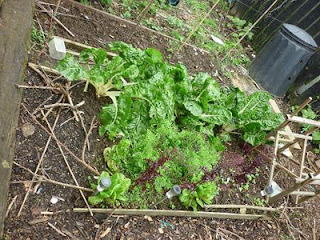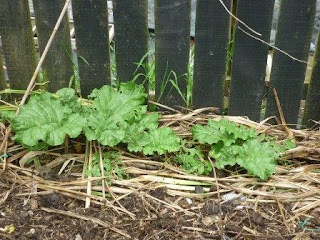Dollar value for space used, salad greens are far and away our most productive crop - they take up little space, and you can go from sowing to harvest in six weeks. After a few years of perfecting my cultivation methods, I think I can now share how to do this, based on a few simple principles.
Mesclun patch (photograph centre) with mizuna and corn salad. Lettuces along front garden edge. Radishes germinating to right, with an old deck chair used as a support for cucumbers.
The first is to have suitable ground, and for our family of 4, about 2 square metres of ground is all that is needed to allow us to pick 2-4 salads per week. The soil needs to hold plenty of moisture, to sustain the crop through the summer months, be relatively fine, and be well composted and limed. In practice, the soil should be roughly 50:50 topsoil and compost, worked to a depth of at least 10 cm, with a dressing of garden lime (like icing a cake) at least twice per year. Within the garden, a full sun position is OK, but if you can find somewhere that gets partial shade during the summer, that is preferable.
With 2 square metres of ground, I would have two 1m2 salad patches.
One patch is used to sow a mesclun mix (Kings Seeds, Original Mesclun mix is what I use). Sow the seeds over a finely worked patch so they fall at roughly one centimetre spacing, rake over with fingers, then press down firmly. Keep well moist at all times and the seedlings will germinate quite densely, and with a follow up weed at 4 weeks, will dominate the patch of ground for several months. Start picking after 4-6 weeks, and keep picking regularly (pull off individual leaves, or cut at 5 cm above the ground with scissors) and keep harvesting the patch until it goes to seed, turns bitter, or production drops off), then dig it over and start the process again. Sometimes I will get 3-4 months of picking off one sowing, and from one seed packet I get at least 10 sowings. So it works out as VERY cheap, fresh, convenient greens. If you use Kings Mesclun Original expect some seasonal variation - I find that in the winter, mizuna and corn salad are dominant, and in the spring, summer, and autumn, mizuna, endive, pak choi, and lettuces are the best growers.
The second patch of 1m2 is used to grow lettuces, radishes, and calendula (for the bright orange petals). Prepare the ground in the same way, and grow loose leaf lettuces like "cos", "lolla rossa" or "oak leaf". Pick them leaf by leaf, and each plant will produce for several months. By planting new lettuces as soon as old ones get pulled out, the supply of lettuce is continuous, and can cover the periods when the mesclun is between sowing and first harvest. Salads with a mixture of loose leaf lettuce, mesclun, and radish can be easily grown year round. If your garden is in the shade in the winter, like mine is, try to sow a patch of mesclun around April-early May. That way the plants can be well established before it gets too dark and wet.
If you have more space to spare than 2m2, shift the patches of mesclun around the garden to achieve crop rotation (which naturally reduces plant diseases), and why not grow some tomatoes, cucumber, and spring onions too?
Happy gardening,
Tim.








